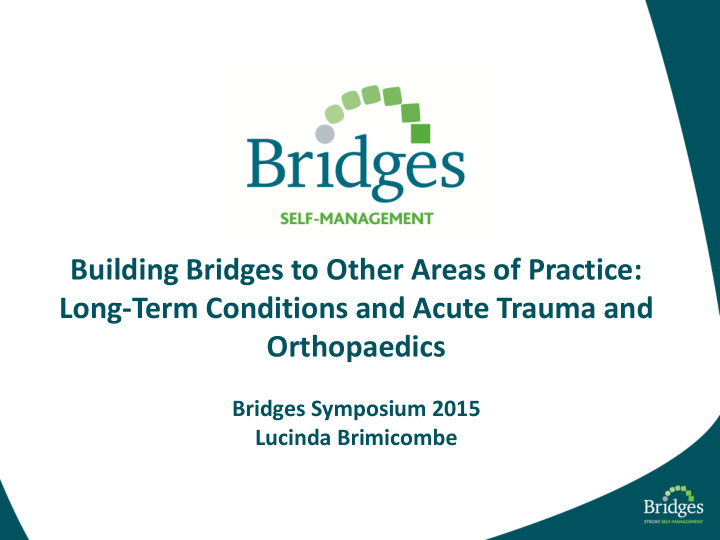



Building Bridges to Other Areas of Practice: Long-Term Conditions and Acute Trauma and Orthopaedics Bridges Symposium 2015 Lucinda Brimicombe
Two projects Enhancing self- management skills for people living with LTC’s in Lewisham Starting early: self- management in acute trauma and orthopaedics, St. George’s Hospital
Enhancing self-management skills for people living with long-term conditions in Lewisham • Helping people with long-term conditions in What? Lewisham become more involved in their health and well-being • To increase access, equity and efficiency of self- Why? management support for people in Lewisham with complex needs • Co-producing a unique self-management support How? package with Lewisham residents that can be integrated into usual practice
Teams involved in the project Social care Health care Third sector • Enablement • Enablement • Age Care Team Therapy Teams UK/Community Connections • Integrated • Lewisham Adult Neighbourhood Therapy Team • Lewisham Teams MindCare
Project plan Implementation • Work shadowing • Patient interviews • Coproduction of self- • Patient outcome measures management book • 3 part MDT, multi agency • Staff feedback training (n=90) • Staff questionnaires • Sustainability • Integrating self- management support: self- efficacy, communication, use of book Pre-implementation Evaluation
Ayotunde, 60, Vesna, 60, Vascular Charlotte, 38, Prabhakara, 77, Brian, 68, ataxia Dementia three strokes arthritis, heart Parkinson’s Disease disease, Alzheimer’s Darren, 19, and his Georgina, 53, Daphne, 79, James, 50, stroke Richard, 32, Mum Faith, Multiple Sclerosis dementia muscular myotonia congenita dystrophy Lewisham contributors
Implementation challenges About staff/services About patients/families • • We are already supporting self- Poverty management • Mental health • We don’t have enough time to • Behavioural problems/alcoholism implement this • Home environment: hoarding, • We don’t see people for long chaotic, infestation enough • Homelessness • Feeling of entitlement, or reliance on ‘the system’ • Family either too involved, or not involved enough • Loneliness and isolation
Staff training feedback “It made me reflect “Maybe we need to “It changes your way “It was extremely on the language I change our thinking of thinking. I look informative and had been using that that we are there to forward to using the thought provoking was counter ‘do with’ rather than book and feeding to share productive to ‘do for’ the client” back to you” professional providing patients experiences” (Enablement (Physiotherapist, with sense of Officer) Community Team) (Social Worker, control” Enablement Team) (OT, Enablement Team)
Bridges in Trauma and Orthopaedics at St. George’s Hospital
Project Aim • To enable practitioners working within acute inpatient setting to develop effective strategies to support self-management with individuals and families after acquired trauma Pre- Post Implementation implementation implementation 3-part bespoke Evaluation, Identify Bridges training, dissemination and champions questionnaire communications Case reflection for Sustainability Work shadowing part 3 meetings Support from Bridges Needs analysis team/champions meetings
Challenges to self-management in acute T&O I kept saying sorry to everyone all the time….I felt like I was annoying them, it was so busy on the ward I just felt like there was more important people, they needed more important things than a sip of a drink With my colostomy bag…I was in so much pain with it, honestly, I look back now and I said to my mum ‘I don’t know how it’s possible for someone to be in that much pain and still be alive’ I really don’t
Learning from others Unique self- Challenges and management tool strategies Record progress and reflections Self-management support Collaboration Rehab and care Sharing expertise interactions Changing focus of therapy/care Self-management support 2 ways
Integrating self-management support: catch phrases Problem Knowledge Reflection solving “What do you “Other people understand “How did that have found it about your go?” useful to…” injuries?” “What have you “How could you “What are you been told, and make it easier struggling with? what does that for yourself next Talk me through mean to you?” time?” it”
Staff knowledge, attitudes and beliefs Significant improvements in • Knowledge about different ways to enhance self-efficacy in the patients I work with • I believe that self-management support takes more time than usual therapy treatments • The main way I support self-management is through giving information • The team I work in has a clear method for including patients in their goals and treatment plans • I feel confident to promote self-management in patients with brain injury
Case reflections Just because a patient is ‘passive’ does not mean they are not motivated – it is about the professional engaging with them early on by listening as they talk about their interests, preferences, hopes and goals Self-efficacy can have a huge role in quick progression as it allows patients to take some charge in a situation generally out of their control. His mood improved when he was able to complete tasks and he would request to sit out of bed to try tasks with our assistance. This approach meant patients did not seem so overwhelmed by their injuries and were able to manage more than they thought
What is self-management in acute T&O? “Breaking institutionalisation and passivity in acute setting (small things can address this from the beginning )” “A deliberate approach to supporting patient- centred care”
Wish list To have the whole team trained to make lasting team changes where everyone is working to help patients to help themselves
A framework for developing, evaluating and implementing complex interventions: Normalisation process theory (May 2009) Coherence • Meaning and sense making i.e. how is self-management different to what we do now? Cognitive participation • Engagement by staff i.e. do we think this is a good idea? Collective action • The work staff do to implement self-management i.e. what effect will it have on our existing practices? Reflexive monitoring • Staff reflect on/appraise self-management support i.e. how do we perceive it after a while?
Thank you!
Recommend
More recommend